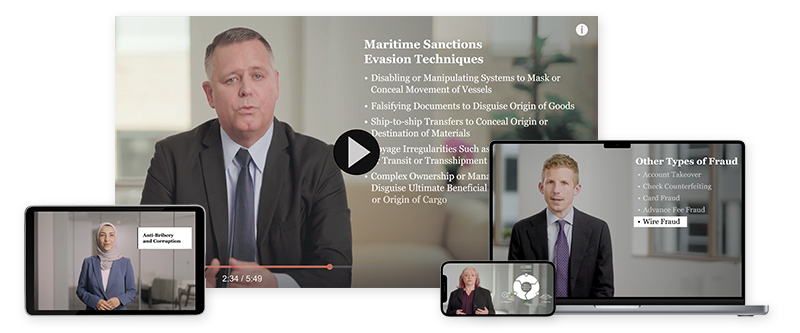The Illusion of Preparedness
The Hidden Risk in Overestimating Your Team’s Readiness
📅 October 15, 2025
📅 October 15, 2025
Everyone passed the training. So how did we still miss the red flags?
It’s the kind of question that keeps compliance leaders up at night—not because they don’t know the answer, but because the answer isn’t easy to hear. On paper, everything looked fine. Completion rates were high. Quiz scores were solid. Policies were acknowledged. But when a real threat appeared, the warning signs still slipped through the cracks.
That’s the illusion of preparedness. It’s when we mistake participation for proficiency, telling ourselves that if the training is done, the risk is handled. The truth? A checklist can’t replace judgment. A certificate can’t build situational awareness. And knowing the rules isn’t the same as being able to act on them when the stakes are high.
Confidence without competence doesn’t make us safer—it makes us vulnerable. And in a world where risks evolve faster than training cycles, that vulnerability can be costly.
The reality on the ground rarely matches the tidy examples in a training module. In the real world, red flags aren’t highlighted in bold. They’re buried in messy data, competing priorities, and incomplete information.
Criminals don’t wait for your annual training update; they adapt their methods constantly. By the time a case study is added to the curriculum, the tactic may already have evolved.
And employees? They’re often making judgment calls under pressure. Maybe they’re onboarding a high-value client with a complex ownership structure. Or reviewing an unusual transaction when the clock is ticking. Or trying to make sense of a sanctions hit that looks suspicious but doesn’t fit neatly into the rules.
That’s where static training falls short. It doesn’t always prepare teams for:
Without realistic, nuanced practice in these gray areas, people may know the policies but freeze, or misjudge when it matters most. And that’s where real-world risk has the upper hand.
Real readiness isn’t about perfect quiz scores or neat completion reports. It’s about what happens when a real situation unfolds—when there’s no script, the clock is ticking, and the stakes are high.
Preparedness shows up when:
When these things are in place, training stops being a box to check. It becomes a living skillset—something people draw on instinctively when the pressure is real and the right call isn’t obvious.
Completion is not capability. Passing a quiz or finishing a module doesn’t mean a team is ready—it just means they’ve been exposed to the information. Real preparedness is about whether they can spot a threat, make the right call, and act with confidence when the stakes are high.
The goal of training should never be to simply check the box. It should be to build teams who can recognize and respond to risk in real time—whether that risk looks exactly like the training example or not.
So here’s the challenge for leadership:
What would it take for your institution to prove—not just presume—it’s prepared?
An on-demand video library designed for today’s risk environment, this expert-led training program makes complex topics clear, practical, and engaging—ideal for onboarding, upskilling, or refreshing core compliance knowledge across your teams.











 Navigating the Convergence of Sanctions Evasion, Export Control Evasion, and...
Navigating the Convergence of Sanctions Evasion, Export Control Evasion, and...This site uses cookies. By continuing to browse the site, you are agreeing to our use of cookies.
Accept settingsHide notification onlySettingsWe may request cookies to be set on your device. We use cookies to let us know when you visit our websites, how you interact with us, to enrich your user experience, and to customize your relationship with our website.
Click on the different category headings to find out more. You can also change some of your preferences. Note that blocking some types of cookies may impact your experience on our websites and the services we are able to offer.
These cookies are strictly necessary to provide you with services available through our website and to use some of its features.
Because these cookies are strictly necessary to deliver the website, refusing them will have impact how our site functions. You always can block or delete cookies by changing your browser settings and force blocking all cookies on this website. But this will always prompt you to accept/refuse cookies when revisiting our site.
We fully respect if you want to refuse cookies but to avoid asking you again and again kindly allow us to store a cookie for that. You are free to opt out any time or opt in for other cookies to get a better experience. If you refuse cookies we will remove all set cookies in our domain.
We provide you with a list of stored cookies on your computer in our domain so you can check what we stored. Due to security reasons we are not able to show or modify cookies from other domains. You can check these in your browser security settings.
These cookies collect information that is used either in aggregate form to help us understand how our website is being used or how effective our marketing campaigns are, or to help us customize our website and application for you in order to enhance your experience.
If you do not want that we track your visit to our site you can disable tracking in your browser here:
We also use different external services like Google Webfonts, Google Maps, and external Video providers. Since these providers may collect personal data like your IP address we allow you to block them here. Please be aware that this might heavily reduce the functionality and appearance of our site. Changes will take effect once you reload the page.
Google Webfont Settings:
Google Map Settings:
Google reCaptcha Settings:
Vimeo and Youtube video embeds:
You can read about our cookies and privacy settings in detail on our Privacy Policy Page.
Privacy Policy